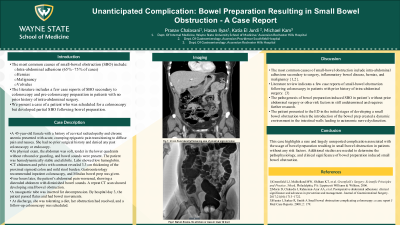Sunday Poster Session
Category: Small Intestine
P1593 - Unanticipated Complication: Bowel Preparation Resulting in Small Bowel Obstruction - A Case Report
Sunday, October 27, 2024
3:30 PM - 7:00 PM ET
Location: Exhibit Hall E

- PC
Pranav Chalasani, MD
Wayne State University School of Medicine / Ascension Providence Rochester Hospital
Rochester, MI
Presenting Author(s)
Pranav Chalasani, MD1, Hasan Ilyas, MD1, Katia El-Jurdi, MD2, Michael Kam, MD3
1Wayne State University School of Medicine / Ascension Providence Rochester Hospital, Rochester, MI; 2Ascension Providence Hospital, Southfield, MI; 3Ascension Providence, Rochester, MI
Introduction: The most common causes of small-bowel obstruction (SBO) include intra-abdominal adhesions (65 % – 75 % of cases), hernias, malignancy, and volvulus. The literature contains a few case reports of SBO secondary to colonoscopy and pre-colonoscopy preparation in patients with no prior history of intra-abdominal surgery. We present a patient who was scheduled to undergo a colonoscopy but developed partial SBO after bowel preparation.
Case Description/Methods: This is a 45 year-old female with a history of cervical radiculopathy and chronic anemia presented with abdominal pain. She described it as acute, cramping epigastric abdominal pain that transitioned to diffuse pain associated with nausea. The patient has no prior surgical history and denied any past colonoscopy or endoscopy. She was hemodynamically stable and afebrile. On physical examination the abdomen was soft, tender in lower quadrants on palpation, without rebound or guarding, and bowel sounds present in all quadrants. Labs were significant for low hemoglobin. Computer Tomography (CT) abdomen & pelvis with contrast showed a focal dense area 3.3 cm thickening of proximal sigmoid colon and mild stool burden. Gastroenterology recommended inpatient colonoscopy for further evaluation. She was given Miralax bowel prep. Four hours later a rapid response was called for worsening abdominal pain. A repeat physical exam showed a distended abdomen with tenderness in the lower abdomen with diminished bowel sounds. To exclude bowel perforation, a repeat CT scan without contrast was ordered. It revealed moderate to marked fluid distinction of stomach and multiple upper and mid abdominal loops of small bowel consistent with developing small bowel obstruction. The general surgery team suggested inserting a nasogastric tube for decompression. On hospital day 3, the patient started passing flatus with subsequent bowel movements. At time of discharge the patient was tolerating diet and her small bowel obstruction resolved and was scheduled for a follow up colonoscopy in an outpatient setting.
Discussion: A literature review identified no cases of small bowel obstruction (SBO) due to colonoscopy bowel preparation. This case highlights SBO in a patient with no prior surgical history. The rapid deterioration, marked by worsening pain and SBO development, underscores the need for vigilant monitoring and timely intervention. The onset of symptoms within hours of administration should raise alarms for a rare cause of SBO post-colonoscopy preparation.
Disclosures:
Pranav Chalasani, MD1, Hasan Ilyas, MD1, Katia El-Jurdi, MD2, Michael Kam, MD3. P1593 - Unanticipated Complication: Bowel Preparation Resulting in Small Bowel Obstruction - A Case Report, ACG 2024 Annual Scientific Meeting Abstracts. Philadelphia, PA: American College of Gastroenterology.
1Wayne State University School of Medicine / Ascension Providence Rochester Hospital, Rochester, MI; 2Ascension Providence Hospital, Southfield, MI; 3Ascension Providence, Rochester, MI
Introduction: The most common causes of small-bowel obstruction (SBO) include intra-abdominal adhesions (65 % – 75 % of cases), hernias, malignancy, and volvulus. The literature contains a few case reports of SBO secondary to colonoscopy and pre-colonoscopy preparation in patients with no prior history of intra-abdominal surgery. We present a patient who was scheduled to undergo a colonoscopy but developed partial SBO after bowel preparation.
Case Description/Methods: This is a 45 year-old female with a history of cervical radiculopathy and chronic anemia presented with abdominal pain. She described it as acute, cramping epigastric abdominal pain that transitioned to diffuse pain associated with nausea. The patient has no prior surgical history and denied any past colonoscopy or endoscopy. She was hemodynamically stable and afebrile. On physical examination the abdomen was soft, tender in lower quadrants on palpation, without rebound or guarding, and bowel sounds present in all quadrants. Labs were significant for low hemoglobin. Computer Tomography (CT) abdomen & pelvis with contrast showed a focal dense area 3.3 cm thickening of proximal sigmoid colon and mild stool burden. Gastroenterology recommended inpatient colonoscopy for further evaluation. She was given Miralax bowel prep. Four hours later a rapid response was called for worsening abdominal pain. A repeat physical exam showed a distended abdomen with tenderness in the lower abdomen with diminished bowel sounds. To exclude bowel perforation, a repeat CT scan without contrast was ordered. It revealed moderate to marked fluid distinction of stomach and multiple upper and mid abdominal loops of small bowel consistent with developing small bowel obstruction. The general surgery team suggested inserting a nasogastric tube for decompression. On hospital day 3, the patient started passing flatus with subsequent bowel movements. At time of discharge the patient was tolerating diet and her small bowel obstruction resolved and was scheduled for a follow up colonoscopy in an outpatient setting.
Discussion: A literature review identified no cases of small bowel obstruction (SBO) due to colonoscopy bowel preparation. This case highlights SBO in a patient with no prior surgical history. The rapid deterioration, marked by worsening pain and SBO development, underscores the need for vigilant monitoring and timely intervention. The onset of symptoms within hours of administration should raise alarms for a rare cause of SBO post-colonoscopy preparation.
Disclosures:
Pranav Chalasani indicated no relevant financial relationships.
Hasan Ilyas indicated no relevant financial relationships.
Katia El-Jurdi indicated no relevant financial relationships.
Michael Kam indicated no relevant financial relationships.
Pranav Chalasani, MD1, Hasan Ilyas, MD1, Katia El-Jurdi, MD2, Michael Kam, MD3. P1593 - Unanticipated Complication: Bowel Preparation Resulting in Small Bowel Obstruction - A Case Report, ACG 2024 Annual Scientific Meeting Abstracts. Philadelphia, PA: American College of Gastroenterology.
